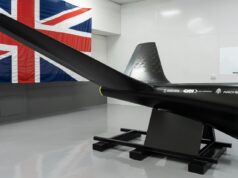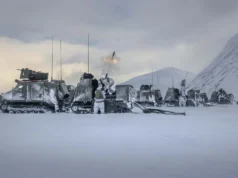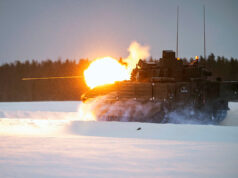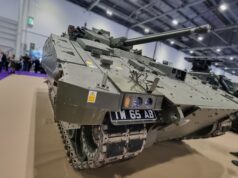The training exercise, dubbed ‘Iron Cyclone’, was hosted on Wiltshire’s Salisbury Plain Training Area.
This pilot exercise was a revamp of the traditional training regimen, focusing on making it more pertinent and challenging.
The primary objective was to enhance the combined arms proficiency of the force, a pivotal factor in ensuring success in today’s combat scenarios.
This exercise involved a comprehensive training package for the King’s Royal Hussars Battlegroup. Collaborating units included the 1st Battalion The Mercian Regiment, 26 Engineer Regiment, 19th Regiment Royal Artillery, and several supporting regiments, offering a chance to cultivate and strengthen their collective capabilities as a new Battlegroup.
Lieutenant Colonel Peter Perowne, the Commanding Officer of the King’s Royal Hussars, offered insights post his regiment’s return from a six-month deployment under NATO’s Operation Cabrit. He highlighted:
“This exercise was about reinforcing the ability to war fight from the lowest level, drawing from the lessons emerging from Ukraine and our Battlegroup experience in Estonia. The core idea was to incorporate these lessons to maximise our lethality, efficacy, and self-protection. The insights from Ukraine have underlined that foundational skills remain vital. This exercise provided an invaluable opportunity to fortify these skills.”
The 3rd (United Kingdom) Division, where the KRH Battlegroup operates under the 12th Armoured Brigade Combat Team, is the British Army’s primary warfighting division. Through Operation Mobilise, there’s a concerted effort to enhance its agility, resilience, lethality, and expeditionary capacities.
Captain William Howlett, Intelligence Officer with the King’s Royal Hussars, commented on the novel approach:
“This pilot exercise introduced a fresh concept. It’s about streamlining processes to benefit our junior soldiers, optimising time and resources to ensure more individuals are trained efficiently and rapidly.”














Mines and artillerie seem the worst for soldiers. Some say they are more feared than ennemy bullets.
Counter artillery and other defences against it are vital IF fighting against artillery. Same with mines. Being able to clear paths, ideally stop them being used in the first place.
Trying to figure out what the army is meant to be prepared for is a struggle.
Dealing with mercenaries,
Helping countries in trouble eg Niger type situation,
A country doing a big invasion of a neighbour and the U.K. goes to help.
Mines are the worst, artillery to a degree can be countered by mobility, that mobility comes at the cost of increased vulnerability to mines. Horrid things.
Correct that’s usually the tactic to guide the opposing forces to manoeuvre themselves into a designated field then sit back and watch the carnage.
The lessons being taken from Ukraine need to be taken with some massive grains of salt. Both sides are using armies that consist mostly of rapdily mobilised and hastily trained personnel, with virtually no air support.
Neither of these statements would realistically hold true for any NATO country.
Ukraine used to have hundreds of warplanes.
Russia still has thousands.
I mean, how much airpower do you need?
Neither of those come close to NATO, and for the record Russia does not have “thousands”: It’s pre-war inventory of fighter and ground attack aircraft comes in at a little over a thousand total.
The European part of NATO alone has about 900 more fighter and attack aircraft than Russia does (So very near 2-1 superiority), backed up by the two largest Airforces in the world (The US Airforce and the US Navy), all of which specialise in operating in contested air defence environments and have advanced SEAD capabilities because Air Support is critical to their way of war.
If the question directed at NATO is “how much airpower do you need” NATO’s answer is “Yes.”
I think that although broadly right, this is a bit misleading. Yes NATO does indeed have better pilots (training), more airframes (though European Air Forces are acutely affected by lack of spare parts), and more advanced weapon packages, potentially.
However Russia do boast a credible airforce certainly, though definitely inexperienced by NATO standards, but with more easily maintained and robust airframes, and large volumes of warheads. I seriously doubt Europe’s militaries can say the same. But much more challenging is Russias air defence systems. The S300s are dated, but the latest upgraded versions would make utter mincemeat of F16s (unlike the near obsolete and amateurishly used ones Sadam Hussein had), and absolutely everyone knows it. Whilst the S400s are allegedly state of the art (must admit I have less knowledge on this).
My point however is that no, NATO would not have effectively uncontested control in a hypothetical confrontation….unless they hit early, en-masse, and without warning. Which would be sensible as we have rather proven we can’t out manufacture Russia in either munitions or equipment, currently.
As a side point, I think it’s important to note that although the Russian military has so far been rather underwhelming in Ukraine, it has also allowed us to recognise that quantity of equipment, munitions, and men are still the key to victory, or defeat. And I hasten to add this is very much our weak spot, and something we need to urgently rectify.
Ross, going to have to disagree mostly with your post, although the comment about quantity aka mass, and the fact in an extended conflict, numbers do matter and have an impact, is true again in certain conflicts. However in regard to the RuAF, their current platforms are not always more easily maintained or robust, but in fact if that was true, then its all the more embarrassing, and shocking the amount of “serviceable” aircraft are hitting the deck of their own accord, through negligence of servicing, pilot incompetence or ground crew inexperience.
In regard to Russian AD systems and defences, NATO forces have trained and equipped to beat these for over 50 years. Yes their systems (do) improve (but see above for the RuAF) but so do NATO TTPs and weapon systems, to overcome and destroy them. Yes NATO aircraft would take losses, any force would, but lets not pretend that they would not be able to render Russian AD systems ineffective.
You are also correct in regard that NATO has let its war stocks reduce to a dangerous level, but its more cost effective, and operationally efficient to fire one guided munition at lets say a Russian Artillery system, than pepper the area with hundreds of dumb munitions. If you speak to the RA lads, they would rather a one shot, one kill systems, in order for them to relocate quickly prior to any Counter Battery fire. It can be horses for courses and in an extended conflict both sides would be using ammunition at an alarming rate, and yes, dumb ordnance is more available, but less effective.
Ukraine has taught us, reminded us, that warfare is not the clinical and clean “tech” battle, But the down and dirty grass roots combat. However lets remember both sides started this war with legacy Russian kit, and its took a while for NATO systems, platforms and training to kick in on the Ukraine side. But if Ukraine had started the war, with the full capabilities of NATO, kit, platforms, ISTAR, training etc in all 4 spheres of combat (to include space) then the vast majority of observers believe that Russian forces would now be beaten, pushed back out of Crimea, the Donetsk etc and there would have already been a regime change in the head sheds. Cheers for taking the time to peruse, take care.
He’s also wrong about production capability though. NATO doesn’t retain a huge stockpile of rusting ammunition of dubious quality like Russia does, but as my reply pointed out, the 3 biggest artillery ammunition manufacturers on the globe are all NATO companies, and the next two are NATO aligned.
It’s also not just that Ukraine started the war with legacy Russian kit, a lot of NATO countries would have done that a year or two ago, before they donated their Russian kit to Ukraine, although that is part of it. Ukraine could have had a pure NATO equipped force, but it would still have been dwarfed by the Russians. This would not have been the case for NATO.
Hi Airborne, I don’t think we are too far off each other, as I actually agree with most of your points completely.
I would contest the Ukraine starting with NATO standard equipment scenario…..purely as that would be so expensive for them to acquire and maintain (without financial support) that the number of platforms would have been insignificant, and thus even more quickly beaten.
Russian airframes may not be as robust as advertised… but I actually think it is as embarrassing as being primarily very low quality maintenance (and training), as with most issues involving largely/partially conscript armies.
There is something I’d like to pick up with you however (though not necessary disagree with), dumb vs smart weapons. I actually think there may be a place for both in the modern battlefield potentially. When we talk about extended conflicts in particular, it might be wise for use to revisit this and have a more blended munition stockpile?
There is definitely a place for both smart and dumb munitions mate, as the smaller the munition it is much harder to adapt a smart fuse or sensor system. Not all tasks will require a smart munition, but with more smart ordnance there is a smaller logistic chain, higher kill probability and quicker in and out of action times. But of course you are correct in that we need decent stockpiles of both, in preparation for any future extended conflict. Cheers.
The Russian airforce is not even close to comparing to NATO’s airpower. Again, as I pointed out European NATO (without the US and Canada) has nearly 2x the air frames of the Russian Air Force, and those include 5th Generation fighters, which Russia doesn’t. Then you add another 2,000 fighters in the USAF and USN. NATO has at least 4x as many airframes as Russia. Then you bring up S-300 and S-400 like it’s a gotcha.
It isn’t. This is the reason I brought up the fact that NATO practices SEAD, and is very good at it (in fact it’s the reason NATO has brought in low radar observable airframes like the F-35 and F-22, and, again unlike Ukraine, has a large stockpile of anti-radiation missiles specifically designed to go after SAM installations).
Please provide proof that we can’t out manufacture Russia in “either munitions or equipment” because the actual facts on the ground are that we are. Russia is burning through it’s Soviet Stockpile, running low on 155 and 122 rounds and forced to bring T-55’s into service as SPG’s because it can use 100mm rounds bought from Iran, and buying ammunition stockpiles from North Korea. Russia isn’t even building many new bits of equipment, instead relying on refurbishing it’s reserve stockpile.
Meanwhile do you know what the 5 biggest ammunition producers in the world are?
General DynamicsRheinmetall AGNEXTERSAABElbitOkay so SAAB and Elbit arent NATO, but they aren’t Russian either. That should give you a clue.
Edit: Btw Russian airframes are not exactly “robust,” spend 5 minutes looking up how many of their aircraft fall out of the sky even when nobody is shooting at them.
The S300+ S400 are like most Russian “wonder weapons” a one trick pony and easy to counter. Don’t believe me, look at the Israeli air forces experiences overflying Syria. They’ve run rings around the S400 and even tricked the system into shooting down Russian aircraft.
Ross is pretty full of shit tbh, I mean at least he’s cogent and not a troll like some of the others, but his main source is clearly Russia Today.
https://www.timesofisrael.com/israel-says-russia-agreed-to-not-hamper-idf-air-campaign-over-syria/
Hi Dern,
Anything related to NATO training and tactics I’m not contesting with you (as it’s patently obvious we are superior in that regard). We also don’t seem to be far off each other on my point that Europe’s militaries would struggle, both in terms of munitions and serviceable airframes. German air force is a well documented example….but I suspect not the only one. In terms of Russian aircraft not being robust, I think you are flat out wrong, don’t confuse bad training, and/or poor maintenance, as bad design. Soviet Russian equipment is well known even by NATO to be much more durable and rugged than our own (keep in mind it’s designed for en-masse use by a conscript army). It’s tech level being perhaps a different point.
On air defence, I don’t believe in ‘Gotcha’ type comments, but it is simply a fact that NATO has has never operated against an organised, trained, contested airspace, let alone against one that have has such a large number of proven air defence systems. Remember that even back in the Cold War the Soviets focused on air defence, whilst we focused on air power. They are not amateurs in this field.
Now in terms of munitions, we are out of 155mm shells that can be given away and instead are providing cluster munitions, be in no doubt why. The Pentagon has never contested that both Europe’s and USA cumulative artillery shell production and stocks pales in comparison to Russia’s, please feel free to review their own statements on that. Similarly, Russian ‘claim’ to be able to churn out 1,200 tanks annually (not incl. refurbishments), now obviously that is a lie….but even if it was only 50% true, that would be several times over our manufacturing ability. Also the T55’s element is widely debunked so I shan’t bother mentioning. Though there IS evidence of Ukraine using them (refurbished of course) on the front line.
You do correctly mention that we host the largest defence manufactures…..in terms of cash size. Not quantity. You also forget that much of Russia’s heavy industry base is deliberately (and well known to NATO) designed for dual manufacture, civilian in times of peace, military when required. We absolutely have no comparable equivalent, and have very little capacity in any field to increase production quickly……which comes to my earlier comments saying we need to improve.
Well thanks for the straw man: we do not agree on European miltaries struggling, infact I specifically pointed out that European NATO alone significantly outnumbers Russian airframes, and that three of the 5 biggest ammunition producing companies in the world are based in Europe: Rheinmetall, Nexter and SAAB. But if you’re determined to pretend that points aren’t raised then you’re just going to be wrong.
Russian aircraft are not “robust.” Sorry to break it to you. The whole “Robust” thing is a myth that basically comes down to Russian propaganda, they need frequent maintenance and FOD plods just like NATO aircraft, and while NATO aircraft safety records have come along leaps and bounds, Russian counterparts are still stuck with safety records that would make the 70’s blush (this is not a “funding” issue btw, at least not entirely). BTW NATO airforces have fought IADS systems that where well organised and equipped, even manned by Russians sometimes. The fact they came away looking pretty terrible is down to the fact that NATO airpower outmatches Russian Airdefence by a considerable margin.
We are not “out of 155mm shells that can be given away.” Nor is Russia outproducing us. The current estimate of production for Russian shell production is about 1.7million, per year, of all calibers. To put that in comparison Rheinmetall’s 155mm production (just that company and just that round) is 600,000 per year. The bit that can’t be contested is the STOCKPILE. Which is rapidly dwindling, this is why Russia is supplying it’s troops with shells rusted together at times.
Also that Russian claim of 1,200 not including refurbishments is absolute bullshit. Nor is the T-55 debunked, Russia has been using them as SPGs (as I said, I guess you don’t know what an SPG is because you then throw in a little Vatnik comment about Ukraine using them “on the front line”). Anyway, the fact that you are saying it’s “debunked” when video footage has emerged of Russia using them kind of shows what sources you are consuming.
No.
That’s not “Defence contractors by cash size.”
That’s “Ammunition manufactureres by number of rounds created.” It’s not a measure of their overall company size, it’s just world wide rank of artilery shell production. (Also your last point is completely inane, Rheinmetall increased it’s shell prodcution from 450,000 per anum to the aforementioned 600,000 per anum between 2022 and 2023, so yes. We can field increases to production very quickly.)
It’s pretty apparent you’ve drunk the Russian cool aid, and are not looking at actual capabilities, just the narrative the kremlin is feeding out, and at the end of the day you are missing the central point: the Ukraine war is not a model of a NATO-Russia war, and we need to take the lessons of this war with a huge grain of salt.
Dern, do not dog whistle that anyone who disagrees with you is somehow suffering from Russian induced propaganda, it does absolutely nothing to strengthen your argument, even less so if you knew who you’re talking to, and besides which, is untrue. I could quiet frankly make the reverse accusation and suggest you simply believe our own Western version by listening to our own media, or simply believe all the Ukrainian propaganda….but as I say, that would not be helpful.
Much like your ‘gotcha’ comment I also don’t indulge in ‘straw men’ tactics, I am not a journalist or politician, thank God.
Now to your more worthy points.
Once again, on the defence companies, you are wrong in specific regards to ramping up production, once again I’ll refer you to Pentagon briefings, and also to lead times for much of the Ukrainian assistance programmes that run into the 6+ years timeframe. That is all one record frankly.
Yes I recognise those production figures (155mm) and absolutely straight off I will tell you the Pentagon openly state they think Russian produces double that amount (a least), in addition to the larger stockpiles that you correctly mentioned. This I think is obviously true anyway as Russian tends to still focus on cheaper dumb munitions/bombs, so quantity would be more likely.
On the T55s, that is precisely what I was referring to, them basically being used as mobile guns, which strikes me as perhaps more useful than say us providing Hawker missiles for air defence…. But let us not pretend that Russia is running out of tanks (i.e. T62 onwards), yet anyway.
Lastly, there is no need to be so tetchy in your responses to me, we are (at least mostly) on this forum all military enthusiasts and pro UK. But that most certainly doesn’t mean we can’t be critical of our (and our allies) abilities. Better that we are, and improve on it.
Ross, do not ignore points, strawman people and use vatnik talking points and then get upset when you get called on it. If you want to use those points go right ahead, but do not expect me to sit by and not draw attention to it.
You can say you don’t induldge in either “gotchas” or “Strawmen” but you’ve demonstrably engaged in both in this thread so I’m adding “lying” to the list of traits you have.
And thank you for demonstrating that you do not know what an SPG is once again.
Anyway, you can try and paint yourself as a “concerened” Western commentator, but your reliance on Russian information, your strawmanning and ignoring points that are raised, and your sneaking in of little non-sequiturs that dig at Ukraine (yes I noticed those) show what you are.
As yet, you’ve done your best to ignore any salient point that disagrees with your pro-Russian narrative, you’ve (succesfully) shifted the goal posts from the fact that the current conflict does not represent anything like what a conflict involving NATO would involved, and when you’ve have replied to a point you’ve either deiliberately misrepresented or answered in vagueries.
So to the only actual point you managed to bring up there: The Pentagon numbers:
Yes. Russia does produce double that figure. I listed their annual production, which you would have noticed if you where engaging honestly.
That’s double the Rheinmetall ONLY ammunition production.
Not double the wests.
Dern, I have no idea who you are, nor how old you are, but you are clearly very triggered, and not really up for civil conversation. Only throwing up ideology and insults (all of which are rather obviously untrue).
So I’ll simply wish you a good day, and a hope you have a better temperament next time we correspond.
And Ross has moved on from Gotchas and Strawmanning to Gaslighting and Ad homimen.
I suggest you learn to be an honest intellocutor and you’ll soon find that people treat you better.
Too many people in the UK of all places seem to be drunk on Russian cool aid as Dern says. Much of this is stuff dating from WW2 where there is no doubt they got their production of good tanks and artillery fully into gear. The Battle of Kursk is another propaganda tool that still gives and gives.
Personally I’m glad to see the Russians take a beating and I look forward to better days for Ukraine as part of NATO.
This war seems to be about where the Russians stick their sunbeds. I hope it hurts and they learn their lesson.
“The Battle of Kursk is another propaganda tool that still gives and gives.”
Oh? In what respect mate?
I have to disagree as you are way off with a lot of the information that you are posting. Simple taking a step back and looking at the bigger picture of what’s happening, Russia has tried and failed for over a year and a half, to defeat a much smaller country….on it’s own border. It should have every logistic and maneuver advantage and has been fought to a standstill. It’s basically playing a home match and is losing. It’s been forced to into mass mobilization and has had over 100k killed and wounded. Speaking of weapons, its been forced to get artillery from North Korea and it’s most effective weapon of late, Shaheed drones, are sourced from Iran.
NATO and the US in particular are not running low on artillery shells. You might be misunderstanding the reporting that is going on around this.
https://www.youtube.com/watch?v=w6CusO9BntE
In any case, if you have watched how the west and especially the US wages war, and for some unknown reason expects the US to get into an artillery duel then you haven’t been paying attention. That’s just not how they fight. Another key but often unreported point is it is pretty much accepted that western intelligence has infiltrated almost every level of the Russian government and military. They knew about the invasion plans before most of the Russian generals did.
I have said it before and I’ll repeat it. A conventional fight between NATO and Russia would last a week at most.
I don’t know… what portion of frontline in the hands of UK? What for
France? Given current Numbers: 20 km for 6 months for France.
When we look at frontlines in Ukraine…
Lets say that professional troupes are ready for offensive operation and that
somehow we are able to cover frontline with reinforcement, who will attack when professional soldiers attack potential is exhausted?
What unit clear mines? Artillery? Someone else´s men?
NATO has around 3.7 million active service personnel. This is 3x the entire Russian Armed Forces, full time contract soldiers and short term conscripts.
Not sure what a professional troupe is, but you are using the incredible dishonest method of comparing a single NATO country to Russia, instead of the entire alliance, which is what realistically would be fighting a modern peer conflict.
Hi Dern, I am not 100% sure of a availability of soldiers from Nato. It has never been tested. Amoung troups that do exists, how many could be send day one to fight the ennemy?
In 1914, France and UK were allied. BEF was 50 k soldier in 2 weeks. French army was about 1,3M men at that stage. Not to say that British army help was not appreciated, quit the countrary in fact, but real numbers matters.
Conscript is far stronger than professional army for territorial war. What would make sense is conscription in Finland, Poland, baltic countries and Romania. This will provide time to expand armies in other friendly countries. All nations from the back row would be ok to send Air force and provide naval blocade. They would also be ok to send a few well traines troops, but at some point, you need manpower to hold the line.
Math the 3.7million number I cited are full time professional soldiers, not reservers, conscripts, and territorials that need to be recalled to the colours.
I specified that in my initial comment.
Th UK has an ever smaller professional army it’s highly likely mobilisation would be needed if we were actually involved in a war.
Again: NATO has 3.7 million active service personnel. Stop doing the “compare Russia to individual NATO states” thing, it is not an honest comparison.
Two areas the UK is very weak in mine warfare and artillery, another area is an effective uav overwatch to try and negate the enemies mine deployment and adequate number of guided rockets to allow the distance to be increased so as to allow us(NATO)our traditional advantage in manoeuvre warfare. Hopefully they are testing this and the higher ups have the balls in the report to say those areas are critically underfunded.
Hi Fosterman,
In artillery, France is not in a great Shake. Caesar canon seem to do well in combat but quantity are simply not there, nor amunition inventory or production. Nothing serious in Himars like solution. We are simply not ready yet. Lately, flying ammunition is becoming a part of artillerie. We are limited yet, but we will be equiped in 2030, with Patroler, Aarok, Eurodrone and tactical ammunition like Colibri and Larinae. I don’t know what will prevail in future (himars like rockets or drones). Both fill the same role, that was before thé one of tactical aviation (A10, Alphajet) and attack hélicoptère (apaches or Tiger). The road is clear. Do you know what UK is preparing? How does UK wants to prevail in long range fire?
Regarding mines, when we look at quantities deployed by both sides in Ukraine, I think nobody as a play, nobody can move. You can have wheels or Tracks, both will be blown up by mines and counter play is far from obvious. What can be done to fix it and regain mobility, I simply don’t know. In France, talks on this topics are not public. But it seems that not easy solution exists. May be mine clearing robots like in sea operations. Hope to see future programs of UK and cooperation of UK and France, it would make a lot of sense!
The French army is in a much better place in terms of artillery and long range missile development. I think it would be beneficial if the UK could team up on long range fires instead of being tied to the US systems mainly down to cost and being tied down into the US missile ecosystem is bad for the army as a whole and industry. The argument for buying American is it’s cheap off the shelf but you get locking into there systems and suddenly the army has 10 different missiles but none are compatible across the fleet so actually it costs more.
Drone development needs a massive shake up in the west especially expendable UAVs that are of sufficient quality but very cheap to produce, this is an area the UK military is performing poorly in with a huge aviation manufacturing industry we should be global leaders in the field but again nothing to show for it.
The only real way I see Ukraine getting through the mine fields is over them with helicopters in decent numbers to allow for combat losses but that will take a brave investment which won’t come. What will happen is the British army will purchase a few dozen mine resistant vehicles and forget about this exercise untill the next war then complain it didn’t get the required investment when the casualties start racking up.
In summary,
*Artillery numbers will stay low.
*Missile development and numbers are a mess.
*Not enough investment in UAVs.
*Army seniors will most likely bury the reports.
*Government continues to tell everyone we have the best army in the world with record investments.
Let’s cross the finger and nock some wood. Cooperation with both nations will rise again soon. Budgets are available and engineering and skilled labor are scarce. Good time to see new project. At least, I would like it to be.
😀 Good effort Math, the saying is “touch wood” not knock wood.
Anyway, welcome to the forum.
Unfortunately, the UK has one of the most opaque military procurement systems in the democratic world- it’s very difficult to know what is going on. The US and others are far more transparent.
That said, there are a number of projects that are going ahead for UK artillery- not sure how many will stick and what status they are.
The UK are currently modernising all (I think, although not sure how many we have) of the M270s (tracked Himars) that they didn’t send to Ukraine, so seems there’s good intentions there. We’re also down as an early customer of the Precision strike Missile, which is the replacement for ATACMs, which should be arriving 2024/25. So, with the standard GMLRS rockets and PSM, longer ranged rocket artillery is fairly well covered- although some wheeled Himars in the mix would be a nice to have. There have also been various mock ups and projects showing Brimstone (and, I think Spear 3) in ground launched configurations on the back of Boxer, but I’m not aware that it’s gone beyond a sales exercise.
There’s a project running to replace AS90 (tracked SPG), but it hasn’t got very far and the Army have procured some Archer systems to cover the units sent to Ukraine as a stop gap. Whether that means that we’ll transfer from tracked to wheeled SPGs completely, or that we may field some of each, is less than clear. Nor are final intended numbers. The presence of multiple videos of Lancet drones targeting SPGs in Ukraine shows there’s a clear need for armoured artillery, in my view. Either way, we’ll be looking for the longer barrel length I expect, as the AS90 was shorter than the more normal 52 calibres and range is also showing as a key factor in Ukraine.
We also operate towed 105 mm guns, which seem that they may still have a place in the order of battle, but no idea if they’ll keep them- or what a reasonable replacement for them would be. I initially thought a self-propelled 120 mm mortar (could be mounted on a number of the platforms that the UK operates or will be operating). But there are apparently some issues with that approach- not least of all the lower range.
So, it’s not all bad, but the biggest problem is probably quantity. The British Army has been reducing the amount of artillery they’ve had for a while anyway, and many of the projects above are not exactly low cost. You’ll notice there aren’t really any clearly scoped loitering munition or artillery spotter UAV projects, certainly not that I’m aware of anyway. There’s Watchkeeper and Protector, but both are high cost units that wouldn’t do well over contested areas. So a mix of good and bad, I suppose.
I am a fan of the complex weapons partnership that the UK and France have, I feel it has been very successful and would be great to see more developments.
Hi Joey,
Thank you for your insights. I agree there is something with loitering ammunition against artillery and understand better why UK may look for 52 caliber tracked vehicule, with armored protection. In France, generals are looking for air transport mobility and see it as a must have. Without capability to project with A400M and easy move on theatre of operations, they will think it will lack Key success factor. I am not sure of anything yet. I hope they are right. In this regard, UK and France developped the 40 mm CTA. It could be used to protect high value assets against aerial threats, like loitering ammunition. What do you think?
Regarding Himars, I don’t know what is right. Based on rockets public prices, around 200k€, with 6 rockets and 500 himars launcher… If it is shouting 5 times a day, you spend 3 Bn€. I think it cannot be sustained by any country. So I am wondering ig it is a dead end or if numbers are inflated. Glad to ear that you are well covered though. Brimstone is a very interesting missile, given it’s swarming abilities. We don’t have such things.
105 is a big question also in France. May be a very good caliber, with sustained fire, nice mobility and simply more shots. Let’s see what future will look alike!
That’s interesting, do you think the French military will look for something like the C-17? I know they found the RAF ones useful in North Africa, and it’s one of the biggest reasons why I’ll be furious if the UK gets rid of their strategic airlift. What would their options be though, seeing as the C-17 line is closed, and I imagine that they’d want an Airbus solution if at all possible.
I’ve no idea if those numbers are right, but that is an awful lot of money flying through the air! Realistically, I don’t think anyone would have 500 Himars on the frontline launching rockets, but it does make you think about ammunition depth and cost.
I’d like to see more use of the 40 mm CTAS, so anti-air would be a good option- mounted with a radar director and electro-optical sites. would make a good close-in system. The more units are bought, and the more types of ammunition produced, the cheaper the weapon system is overall- good for both of our militaries!
Anti-personnel weapons are the worst for getting into the soldier’s psychic.
I wonder what the ‘fresh new concept’ was, as mentioned by Capt Howlett?
Incorporating some LL? That’s pretty standard – and isn’t really a new concept.
Mines are now taking a new front seat, after years of the liberal west saying mines (certain types) are very naughty and we shouldn’t have them, or use them. Mines, to include off road mines, are the best way of countering an enemy thrust, directing and channelling vehicles and people into pre determined killing zones, area denial and general worrying the shit out of the enemy planners (and in he offense just as essential for flank protection etc), just as . We need to be thinking and getting back to platforms (such as Shielder) which are able to bang out some serious mine numbers in a short period of time. Farouk, over to you!!!!!
ahh the mark 7 anti tank with a mark 5 fuze clicked for a tilt fuze, those were the days, I think we might need to lend Dern and Ross our Glock and CZ though at this rate. I love a heated discussion especially when I’m not involved in it. Lol.
Agreed mate, Dern is in fact always on top of his game and knows his stuff, from both experience and decent research. If Dern pushes out a few facts (and reading the conversation) he is the one giving facts, correct and up to date info and keeping to the thread without pushing some misdirection, which Ross does seem to be doing. However like you, I love a good heated debate, and like you it makes a change I’m not in “contact” or collateral damage lol
I am always impressed with the amount of knowledge some people have, makes very interesting reading and as I am not current with tactics and weapon systems of today it is fascinating how current or future conflicts will evolve, still boils down to some poor grunt covered in crap, cold and tired having to take and hold land, that never changes.
Spot on, I thought the tech we had when I was in, was on the ball, but 8 years later after getting out (I still live in Colchester) speaking to the blokes and reading, it’s come on even more in leaps and bounds! But again, war, it’s all about taking and holding ground, something many advocates on here and elsewhere who always talk about drones replacing this that or another platform, forget! But we have some excellent SMEs on here and other guys who have an encyclopaedia knowledge of the military, and it’s always great to read and learn. 👍
Agreed. Dern is another SME here, for good reason. I think his ORBAT knowledge even makes me blush! 🙄😆
Agree on Shielder. I wonder whether the RMCS has any hidden away!
IMO, one lesson to take from the Ukr war is how easy it is for pre war assumptions and planning to be wrong. Remember, the day before the war Russian planners thought that Ukraine was ready to roll over, there would be limited effective resistance and the Russian army would overwhelm any that there was.
NATO must learn that lesson as well, that whatever assumptions they may make about their own and other’s capabilities before hostilities commence (i.e., NATO air superiority/ supremacy for instance) may not withstand first contact with the enemy.
I should imagine lessons are being learned on a daily basis, as It is after all, a ‘proxy war’ being fought there.
Manufacturing technology has allowed drones to be produced cheaper than ever before. Drones used as Kamikaze ‘missiles’ are a massive threat in todays world. Drone use alone, could bring into question all manner of tactics, for Infantry and armoured deployments.
Thus far, the only battlefield vehicles that may have a long term future, are Infantry vehicles, and even they may need to be totally re-thought in terms of speed and mobility.
The lack of aircraft being able to ‘do their job’ to the full, may also bring into question their place on a battlefield. Rockets of all types, manner and sizes is making their role more problematic than ever before.
$100m for a gunship v $100,000 for a star streak missile… so scrap a gunship, buy 1000 missiles, = I would fly away quickly if I were a pilot.
Maybe the future of warfare on a large scale, could boil down to Infantry, Dune Buggy’s, lots of drones, lots of missiles and trench rushing.
Tom, why do you think Infantry vehicles are somehow immune from drone (and other) attacks?
Hi GM
I don’t think they are immune. Infantry vehicles will themselves be targeted, if the enemy has enough drones and missiles to do that, after they have finished off the oppositions tanks.
Graham,
Article published today (Business Insider) stated CR2 has joined the UKR counter-offensive w/ the 82nd Air Assault Brigade in the Zapporhizia oblast, near a city/Hamlet/village named Robbotyne (all UKR spellings are at best approximations). Evidently, the CR2 have been outfitted w/ an anti-drone cage attached to the turret. Hoping for good fortune and combat effectiveness. 🤔🤞
Thanks mate. I have been bemused that such a heavy tank was issued to air assault forces (in our army the airborne/air assault operate the lightest of equipment!).
Good fortune to them, as you say.